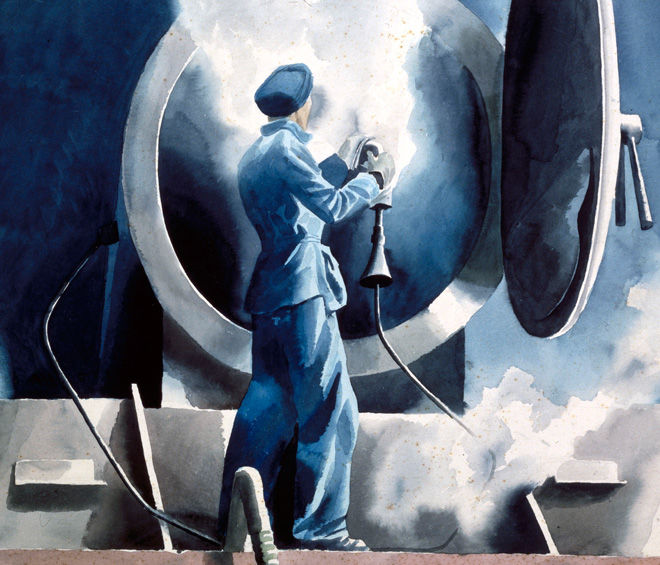
Cliff Rowe, Woman Cleaning a Locomotive in St Pancras Cleaning Yard, 1942. National Railway Museum, York. © Anna Sandra Thornberry, daughter.
by ANNA McNAY
Christine Lindey’s recent publication, Art for All. British Socially Committed Art from the 1930s to the Cold War, looks at a mid-century era of artists deeply committed to their political beliefs and prepared to voice these unabashedly through their work. During eight years of research, Lindey uncovered many new or little-known names and her finished book reveals this untold story of 20th-century British art history, presenting 30 artists and looking not only at their work and activism, but at their background, education, means of patronage and struggles to make ends meet.
Studio International spoke to Lindey by email* and telephone to discuss some of this fascinating and inspiring history and to pull out contemporary resonances and lessons that might be learned.
Anna McNay: Your recent book is entitled Art for All. British Socially Committed Art from the 1930s to the Cold War. How would you define “socially committed” art or a “socially committed” artist?
Christine Lindey: To avoid longwinded differentiations throughout the book, the term “socially committed” is used generically to encompass the wide variety of art and artists considered. “Socialist art” would denote the direct political content of some works, but exclude many others, and “socially conscious” implies passive handwringing over social injustice. “Socially committed” suggests an active engagement with social change. It thus encompasses implied as well as direct political content, so allowing the flexibility needed for the consideration of a wide gamut of works ranging from paintings to posters.
AMc: How did you define the period encompassed by the book and what interested you particularly about these times?
CL: British socially committed artists of the 1940s and 50s were marginalised by cold war arbiters of taste, for political reasons. The aesthetics that dominated initial accounts of the period became enshrined in subsequent art history, much of which still implies that the surge of 1930s socially committed art soon petered out, until renewed interest by 1960s artists. I found it hardly credible that all the 1930s artists had retreated to an ivory tower, or that no younger socialist ones had emerged. I set out to identify and reclaim these artists and their art in order to redress the art history of this era. I then included a chapter on the 1930s when my research revealed it to be at the roots of the aesthetic and ideological debates in the second world war and the first phase of the cold war.
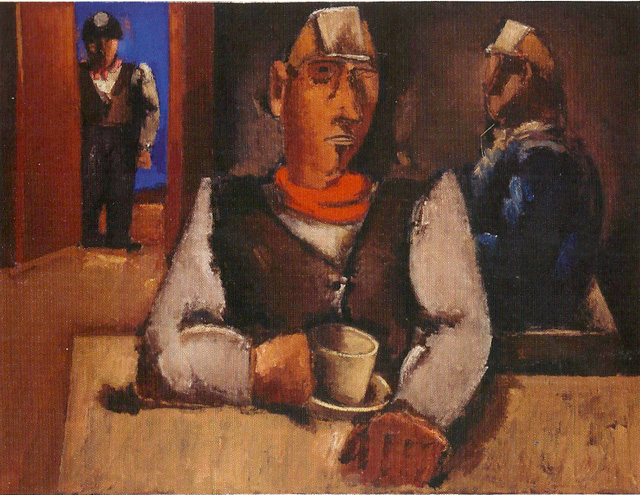
Josef Herman, Miner in the Canteen, c1954. Oil on canvas, 91.4 x 122 cm. Aberdeen Art Gallery and Museums, © The estate of Josef Herman. All Rights Reserved, DACS 2017.
AMc: The book was eight years in the making, so it is clearly a subject you are devoted to. What was it that drew you to working on this topic or this time period in the first place?
CL: My book Art in the Cold War from Vladivostok to Kalamazoo (1990) pioneered the comparative study of Soviet and western art. At Birkbeck College, I devised and taught courses on this topic and on 20th-century realist art, and, more recently, a course on Socially Committed Art from Courbet to Now. My new book grew out of these and I chose British art within this to narrow the focus.
AMc: The book looks at the work of about 30 artists. I must confess to not recognising that many of their names. How did you select who to include – and who to exclude?
CL: I tried to choose artists to exemplify the range of gender, class backgrounds, preferred mediums, aesthetic outlooks and the overlapping generations involved.
AMc: For example, you have not included Henry Moore or Barbara Hepworth, despite their being staunch supporters of leftist politics, or the likes of Joan Eardley or Norman Cornish, whose works dealt a lot with working-class life …
CL: An important criterion for my selection of artists was to find and provide evidence of each artist’s socialist beliefs. I excluded artists such as Moore and Hepworth, who were staunch supporters of the left, but who did not believe in expressing their politics in their work. I excluded artists such as Cornish and Eardley, who depicted working-class subjects, because I found no evidence of their political beliefs or desire to convey these in their work.
AMc: Obviously he predates your defined period, but where does William Morris stand in relation to the ideas you discuss?
CL: His socialist belief in democratising access to art, and his opposition to hierarchies within fine art and design inspired artists.
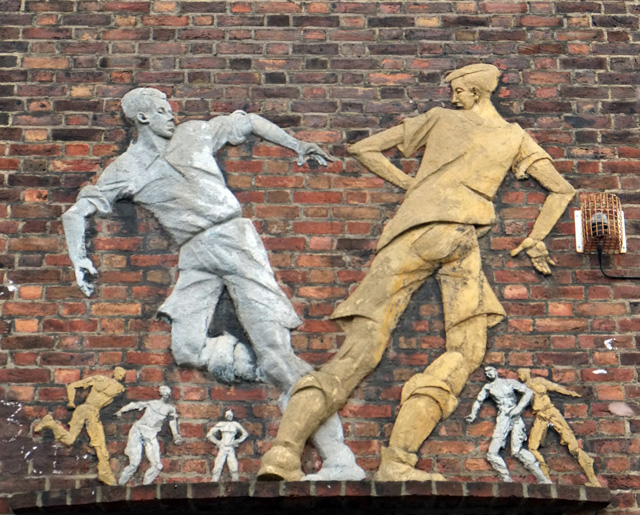
Peter Perí, Footballers, 1949. Coloured concrete. Wareham House, Fentiman Road, former LCC Estate, Lambeth, London. Photo: Nick Wright.
AMc: If you had to pick just three artists to tell your story through, or to be the headliners, who would they be and why?
CL: This is very difficult to answer, as shortlisting 30 artists was already a challenge! May I choose four, instead?
AMc: Of course!
CL: OK. In that case, Cliff Rowe is vital as a founder of the AI (Artists’ International) and AIA (Artists’ International Association) and for his continuing commitment to the cause throughout the period (and beyond) through his work, his writing and his organisational activism. Peter Perí is important as his work exemplified public sculpture and, like Rowe, for his continuing commitment to the cause throughout the period (and beyond). Also for being a major influence on British artists when he arrived as a political and racial refugee in 1993, for his personal experience of activism in the 1919 Hungarian Soviet, and in German socialist art and politics in the 1920s and for his opposition to German nazism until 1933. Thirdly, I’d pick Peter de Francia for his courageous and masterly political history paintings in the late 50s, when this was the most disparaged genre by the dominant aesthetic. And, finally, Eva Frankfurther, the youngest artist in the book, for her dogged refusal to conform to the dominant post-second world war formalist aesthetic, and for her sensitive and honest paintings of the working class, among whom she chose to live and earn her living.
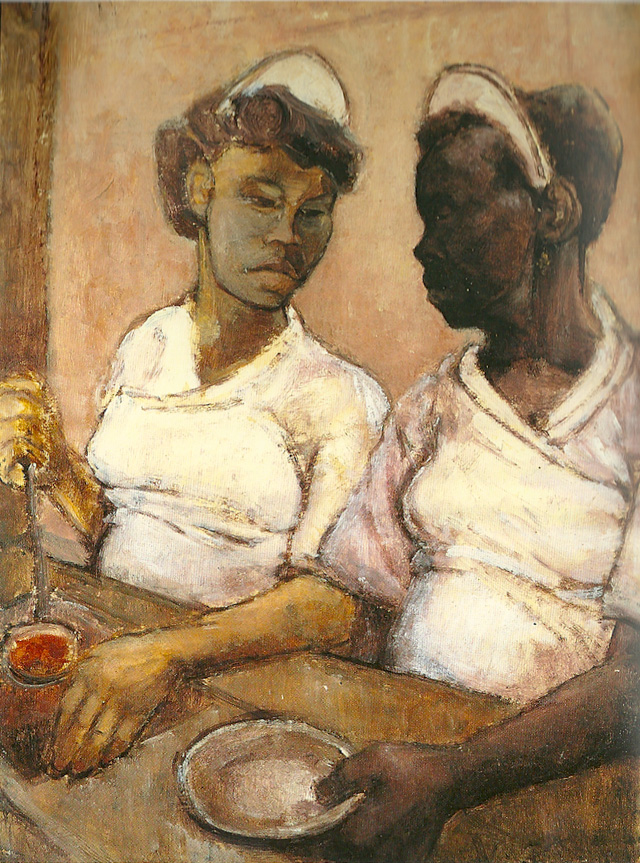
Eva Frankfurther, Afro-Caribbean Waitresses, c1955. Oil on paper, 76 x 55 cm. Ben Uri Gallery & Museum Ltd (Bridgeman Images). © Mrs B. Planskoy
I think one of the problems is that nearly all the artists included in the book are men. It was such a sexist era, especially the 50s. So, there aren’t that many women to choose from, but I will pull out Frankfurther, partly because, whenever anybody sees the book, they almost always remark on her painting. She is one of the discoveries. People say: “Wow.” I also think she was very brave. She was a Jewish émigré, who came to Britain with her family when she was about nine years old, in 1939. She was really quite traumatised because she was old enough to have witnessed a lot of antisemitism in Germany before they finally left. Plus, her mother had died, although that was nothing to do with the antisemitism. She lived with her family in Hampstead – a bourgeois, comfortable family – but she chose to go and live in the East End of London and earn her own living. She lived in pretty grim circumstances there. She refused to show her work through the commercial gallery system because she didn’t agree with it from a socialist point of view. She was only 29 when she took her own life.
AMc: You say there weren’t many women in the period working as artists. Do you think it was just that they weren’t known, or that they truly didn’t exist? You mention a few in your introduction – specifically Margaret Finton and Sheila Dorrell – whose biographies were lacking, and who therefore you could not include. You suggest that this line might warrant further research. Is this something you plan to undertake?
CL: Yes, absolutely. It’s a difficult one. I found it very hard to find any information about these people, but there were actually quite a lot of women artists at the time. I’ve done quite a bit of work in the archives, especially the AIA archive, and also looked at their publications. Women appear all the time in the lists of names of artists showing works in the exhibitions, but it’s the same-old story – nothing happens, they don’t get picked up, they’re not included in later exhibitions, they get ignored. I’m in touch, in fact, with the daughter of one of these women. One of my next projects is to go and see her. A lot of my primary research was talking to the children of these people. And they’re in their 70s, even 80s, now, so I’d better get my skates on! She said that generation of women simply ended up supporting their husbands. It’s just what they did. Like Lee Krasner did for Jackson Pollock. They felt it was their role. And, of course, in those days, childcare was more time-consuming. And they didn’t have washing machines, they didn’t have as much support and the men didn’t help out. Even in my generation, I’ve seen women lose confidence when they haven’t been working for 20 years. Perhaps they haven’t been in the public arena. They’ve been at home washing, cooking and cleaning, and then, somehow, they might continue doing a bit of painting, but finding that desire to promote themselves is much more difficult. During the war – this is something I mention in the book – the number of women on committees was high. They were very active in keeping the organisation going, but they don’t seem to have promoted their own work as much.
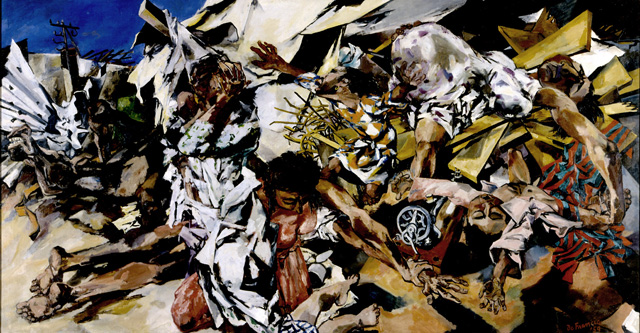
Peter de Francia, The Bombing of Sakiet, 1959. Oil on canvas, 190 x 365 cm. © Estate of Peter de Francia, courtesy James Hyman Gallery, London.
AMc: You’ve mentioned the AI. It was founded in 1933, later transforming into the AIA, and, as an organisation, its trajectory might be seen to mirror the influence of Marxist and socialist ideas in the British art world. Can you say a bit about the organisation, its aims, its successes, and why it ultimately failed?
CL: The AI was founded to encourage patronage, to democratise access to art and to foster socially engaged art. If you read its manifesto, it’s based entirely on Marxist principles. It held exhibitions in Whitechapel, which, in those days, was a poverty-stricken area where nobody went. People were scared to go there. It tried very hard to make art accessible by, for example, producing prints, which were relatively cheap to buy. In 1935, it mutated into the politically milder AIA. I don’t know if you know much about the Popular Front? There was a general move against the rise of fascism, with Hitler having already invaded several countries and Mussolini having set up a dictatorship in Italy in 1925, and then in Abyssinia. So, progressive people generally, which would often include artists who tended to be left-leaning, even if they weren’t particularly political in those years, created the Popular Front because of the fear of fascism.
The AI, in its transition to the AIA, widened its membership to become more inclusive – and therefore less rigidly Marxist. This meant that many famous names joined who otherwise might not have. People such as Henry Moore and Barbara Hepworth, for example. It also meant, of course, that the organisation had much more money and was able to hold more sophisticated exhibitions, which were more likely to be reviewed. The AI was a really small, radical organisation, whereas the AIA became more influential.
It was an important focus for anti-fascist agitation by artists. During the second world war, the AIA flourished, and it remained the socially committed artists’ main source of patronage. This continued in the postwar years, but then, of course, during the cold war, people took sides, and the divisions and opposing ideologies started to come out. It became an absolutely vicious ideological battle, which, in the end, the rightwing section won. I’ve read a lot about what happened in the meetings during this period. In the end, they hoisted their own petard, and the AIA degenerated into an ineffectual exhibiting society which had lost its raison d’être. It just petered out really and the socially committed artists lost their major source of patronage and forum for democratising art.
AMc: Has there not been anything like it since?
CL: There was some attempt to form a kind of artists’ union in the 70s. I remember knowing a few people who were in it. There is, however, a strong belief in the British art world, which can be traced back to the 19th century, which is that art and politics don’t mix. Richard Long was saying exactly the same thing on Radio 4 this morning. The other thing is that artists tend to be loners, so it is quite hard to get them organised into any union. In a way, what power would they have? How can they go on strike? No one is going to notice if they stopped working. So it’s a difficult field to organise. What’s amazing is that the AIA managed it for so many years.
AMc: What about the Arts Council, which was founded in 1946? How did that fit into the story?
CL: The artists initially welcomed the foundation of the Arts Council as it fulfilled socially committed artists’ long-expressed calls for state patronage of living art. But their hopes were dashed when it moved from its inclusive “Best for the Most” policies to its elitist “Few, but Roses”policies, which – despite some exceptions – favoured modernist high art.
AMc: What are your feelings towards the work of the Arts Council today?
CL: Public funding decisions by committee are inevitably hampered by the rigidity of regulations and targets, and breaking [the council] up into regional units has made it rather parochial. Nevertheless, although it is not perfect, I support public funding for the arts.
AMc: Aside from gender, were there other factors that defined the artists who tended to be socially committed, according to your definition? Did class play a role as well?
CL: Yes, I found this really interesting because it was an absolute discovery. I had no idea. First, I didn’t quite understand how the art-school system worked in those days, because, as you’ve probably noticed, almost half the book is about how artists survive, their education, their social background and their patronage. There was a system where most working-class children left school at 14 in those days, but you could then transfer to art school. They tended to be local art schools, which didn’t have as much prestige as the London art schools, such as the Slade or the Royal College, where the more middle-class students went on to after their time in higher education. Cliff Rowe is, again, a good example, he went to Wimbledon Art School when he was 14, I think. People like him tended to be encouraged to go into illustration because it was felt that they would be more likely to earn a living that way. So, yes, there was an effect of class background on the artists’ education. And also, of course, the more working-class artists didn’t have the social contacts that you get in the top art schools, through tutors recommending you to a dealer or for a group exhibition – that kind of thing. But quite a few of the artists in the book are genuinely from working-class backgrounds. Their parents were carpenters or weavers or worked in the textile mills. They were factory workers. They were genuine proletarians as opposed to craftspeople.
The other thing, of course, is how some of the artists were encouraged to take up a trade by their families, who wanted them to have what they hadn’t had. If your father was an unskilled textile-mill worker, he might be the kind of parent who would get you an apprenticeship somewhere, so that you had a trade. Some were encouraged to become printers, which was a very respected trade. They were the kings of the working class. They were very well paid, and it was really skilled work. The Polish émigré artist Josef Herman was apprenticed to a printer when he was 13. It was quite a visual trade and apprentices were often encouraged to go further and learn to be a typographer or a master printer. Then you would find yourself making your own prints or drawings. Sadly, all these trades have become digitised now.
AMc: Is there a particular resonance or relevance for the social or political situation in those times, or the stance taken by artists, today?
CL: Yes, the current revival of interest in socialism, especially by the young, is expressed in the visual arts. This development springs from a similar revulsion at social inequality and injustice as in the 1930s, and by opposition to a frightening growth of far-right ideologies in Europe and in North and South America.
AMc: How about for young artists seeking to start out and make a living today?
CL: It seems to be as difficult now as then, if not more so, for young artists to make a living, as part-time teaching jobs in art schools have dried up and the market-driven art world is even more dictated by fads and fashions. From what I can gather, the art schools teach people not to make political work nowadays.
AMc: It’s more about finding a brand, isn’t it, and something that’s going to sell well?
CL: That’s right. Don’t rock the boat. I don’t think that it was actually that different in those days though. I’ve looked at a lot of rear-guard art. Because the artists wanted to be accessible, they couldn’t make work that was very avant garde. So, they were again going against the grain of the dominant aesthetic, which was that you’ve got to be innovative. The interesting thing, if you look at real rear-guard art, is that it hasn’t got that progressive content. It’s traditional in its style – Victorian ladies staring out of windows and so on. Some of it’s absolutely dire, but the artists made a good living. So there was this kind of middle ground that never got into art history, which only stressed innovation and the avant garde. We’ve got a very distorted view of art history. There was Jackson Pollock and there was minimalism, that’s how I was taught. A sequence of -isms. But many artists weren’t working like that at all.
AMc: You have spent your career in academia, albeit as an art historian rather than in fine art, but what is your evaluation of the current situation of art in education in general?
CL: In my earlier career, I taught in art schools for many years. I am in touch with ex-colleagues and it seems that, for the past decade and a half, art education has been increasingly under-resourced, understaffed and subjected to the negative influences of managerialism and marketisation. Staff are overworked and students not given enough access to their tutors.
AMc: How do you think this affects wider society? For example, as you discuss in the book, in 1960, the TUC adopted Resolution 42, officially recognising “the importance of the arts in the life of the community”. Do you think this recognition has been lost? What could be done to bring it back?
CL: This is not only a matter for the TUC. We need more public funding for the arts. Legislation giving local authorities a statutory requirement to support the arts, with adequate funding to support this, would help. As would reinstituting the importance of the arts in primary and secondary education, which has been marginalised due to the target-driven focus on “core” subjects to satisfy school league tables.
AMc: Do you believe there are socially committed artists working in the UK today?
CL: Yes, there are many. For example, Banksy, Grayson Perry, Mona Hatoum, Jeremy Deller, Peter Kennard, the Forensic Architecture collective (shortlisted for the Turner Prize in 2018), and several artists in the New Contemporaries 2018 exhibition as well, including Mohammed Sami and Ayo Akingbade, with her inspiring 16mm film. Gustav Metzger, who died in 2017, was another good example.
AMc: What are the key lessons to be learned from the period of socially committed art and the work of the socially committed artists in your book? What were the key achievements and what could we take from these today?
CL: By opposing the dominant aesthetic, many of the artists paid the price of limited or minimal professional recognition for non-commissioned works, while their agitational works were not considered to be “real art”. Their commitment to accessibility conflicted with the mid-20th-century obsession with formal experimentation, and led most to a lack of financial and professional success. But the artists fought back by organising their own patronage, and their agitational work supported the Labour movement and progressive politics. What is truly inspiring is that the artists’ principled adherence to their political convictions motivated them to resist conforming to the dominant cultural power. Their works asserted the social importance of working people and of their right to peace, dignity, and social justice, in the darkest of times. And they evoked the social ambiences and political preoccupations of their era. I hope that today’s artists will be inspired by their integrity and their commitment of their art to sociopolitical change, despite being marginalised or just tolerated by the dominant art world. Importantly, history teaches that progressive change comes from disparaged outsiders.
* For some of her emailed answers, Lindey sent edited excerpts from her manuscript, as she felt these provided the clearest possible wording. Permission has been provided to run these along with the answers she gave by telephone.
• Art for All. British Socially Committed Art from the 1930s to the Cold War by Christine Lindey was published by Artery Publications, October 2018.